Abstract
Due to the lack of human avoidance analysis, the orthosis cannot accurately apply orthopedic force during orthopedic, resulting in poor orthopedic effect. Therefore, the relationship between the human body’s active avoidance ability and force application is studied to achieve accurate loading of orthopedic force. First, a high-precision scoliosis model was established based on computed tomography data, and the relationship between orthopedic force and Cobb angle was analyzed. Then 9 subjects were selected for avoidance ability test grouped by body mass index calculation, and the avoidance function of different groups was fitted. The avoidance function corrected the application of orthopedic forces. The results show that the optimal correction force calculated by the finite element method was 60 N. The obese group had the largest avoidance ability, followed by the standard group and the lean group. When the orthopedic force was 60 N, the Cobb angle was reduced from 33.77° to 20°, the avoidance ability of the standard group at 50 N obtained from the avoidance function was 20.28% and 10.14 N was actively avoided. Therefore, when 50 N was applied, 60.14 N was actually generated, which can achieve the orthopedic effect of 60 N numerical simulation analysis. The avoidance effect can take the active factors of the human body into consideration in the orthopedic process, so as to achieve a more accurate application of orthopedic force, and provide data reference for clinicians in the orthopedic process.
摘要
由于缺少人体躲避分析, 矫形器在矫形时不能准确施加矫形力, 致使矫形效果不佳。因此研 究人体主动躲避能力与施力之间的关系, 从而实现矫形力的精准加载。首先基于CT数据建立高精 度的侧弯模型, 分析矫形力与Cobb角之间的关系;然后选取9名受试者按体重指数分组进行躲避能 力试验, 拟合出不同群体的躲避函数;最后通过躲避函数修正矫形力的施加。结果显示:偏胖群体 的躲避能力最大, 其次是标准群体、偏瘦群体;数值模拟分析矫形力60 N时, Cobb角由33.77°减 少为20°, 由躲避函数可得标准群体在50 N时躲避能力为20.28%, 主动躲避掉10.14 N, 因此施加 50 N时, 实际产生了60.14 N, 能够达到数值模拟分析60 N时的矫形效果。躲避效应可将人体主动 因素考虑到矫形中, 实现矫形力更加准确的施加, 为临床医师在矫形中提供数据参考。
Similar content being viewed by others
References
DREISCHARF M, SHIRAZI-ADL A, ARJMAND N, et al. Estimation of loads on human lumbar spine: A review of in vivo and computational model studies [J]. Journal of Biomechanics, 2016, 49(6): 833–845.
ZHANG A P, LIU X, LIU Z F, et al. Manufacture of customized orthosis in adolescent idiopathic scoliosis and comfort evaluation based on 3D printing [J]. Journal of Beijing University of Technology, 2017, 43(4): 518–525 (in Chinese).
ZHANG C, ZHAO Y, DU X Y, et al. Biomechanical analysis of the lumbar spine and pelvis in adolescent id-iopathic scoliosis with lumbar major curve [J]. Chinese Journal of Tissue Engineering Research, 2020, 24(8): 1155–1161 (in Chinese).
WANG H, TETTEROO D, CHRIS ARTS J J, et al. Quality of life of adolescent idiopathic scoliosis patients under brace treatment: A brief communication of literature review [J]. Quality of Life Research, 2021, 30(3): 703–711.
BARBA N, IGNASIAK D, VILLA T M T, et al. Assessment of trunk muscle activation and intervertebral load in adolescent idiopathic scoliosis by musculoskeletal modelling approach [J]. Journal of Biomechanics, 2021, 114: 110154.
RASMUSSEN J, T0RHOLM S, DE ZEE M. Computational analysis of the influence of seat pan inclination and friction on muscle activity and spinal joint forces [J]. International Journal of Industrial Ergonomics, 2009, 39(1): 52–57.
LI D. Analysis of the relativity of the material attribute, modality attribute, configuration attribute of lumber based on the 3D modality data of MDCT and the fracture risk using the finite element method [D]. Changchun: Jilin University, 2011 (in Chinese).
MORGAN E F, BAYRAKTAR H H, KEAVENY T M. Trabecular bone modulus-density relationships depend on anatomic site [J]. Journal of Biomechanics, 2003, 36(7): 897–904.
RHO J Y, KUHN-SPEARING L, ZIOUPOS P. Mechanical properties and the hierarchical structure of bone [J]. Medical Engineering & Physics, 1998, 20(2): 92–102.
JIA S W, ZHANG S X, FAN S C, et al. Finite element analysis on scoliosis lumbosacral vertebral structure and its deformation trend [J]. Journal of Medical Biomechanics, 2017, 32(3): 235–241 (in Chinese).
NIE W Z. Research on thoracolumbar biomechanical modelling and application — the basic issue of mechanical visual human of China [D]. Shanghai: Shanghai Jiao Tong University, 2009 (in Chinese).
GOEL V K, KONG W, HAN J S, et al. A combined finite element and optimization investigation of lumbar spine mechanics with and without muscles [J]. Spine, 1993, 18(11): 1531–1541.
YAMAMOTO I, PANJABI M M, CRISCO T, et al. Three-dimensional movements of the whole lumbar spine and lumbosacral joint [J]. Spine, 1989, 14(11): 1256–1260.
BUSSCHER I, VAN DIEËN J H, KINGMA I, et al. Biomechanical characteristics of different regions of the human spine: An in vitro study on multilevel spinal segments [J]. Spine, 2009, 34(26): 2858–2864.
SUN W X. Predictors of bracing failure in patients with adolescent idiopathic scoliosis & application of grayscale inversion radiographic view in spine measurement [D] Nanjing: Nanjing University, 2017 (in Chinese).
ZAFARPARANDEH I, ERBULUT D U, LAZOGLU I, et al. Development of a finite element model of the human cervical spine [J]. Turkish Neurosurgery, 2014, 24(3): 312–318.
COBETTO N, AUBIN C E, CLIN J, et al. Braces optimized with computer-assisted design and simulations are lighter, more comfortable, and more efficient than plaster-cast braces for the treatment of adolescent idiopathic scoliosis [J]. Spine Deformity, 2014, 2(4): 276–284.
TAJDARI M, PAWAR A, LI H Y, et al. Image-based modelling for Adolescent Idiopathic Scoliosis: Mechanistic machine learning analysis and prediction [J]. Computer Methods in Applied Mechanics and Engineering, 2021, 374: 113590.
NEGRINI S, GRIVAS T B, KOTWICKI T, et al. Why do we treat adolescent idiopathic scoliosis? What we want to obtain and to avoid for our patients. SOSORT 2005 Consensus paper [J]. Scoliosis, 2006, 1:4.
Du Q. Study of rehabilitation evaluation and treatment of adolescent idiopathic scoliosis[D]. Shanghai: Shanghai University of Sport, 2014 (in Chinese).
LI M, WONG M S, LUK K D K, et al. Time-dependent response of scoliotic curvature to orthotic intervention: When should a radiograph be obtained after putting on or taking off a spinal orthosis? [J]. Spine, 2014, 39(17): 1408–1416.
Author information
Authors and Affiliations
Corresponding authors
Additional information
Foundation item: the Applied Basic Research Program of Educational Department of Liaoning Province (No. LJKZZ20220058)
Rights and permissions
About this article
Cite this article
Zhu, Y., Ren, D., Zhang, S. et al. Biomechanical Analysis of Scoliosis Orthopedic Force Loading with Human Avoidance Effect. J. Shanghai Jiaotong Univ. (Sci.) (2023). https://doi.org/10.1007/s12204-023-2620-0
Received:
Accepted:
Published:
DOI: https://doi.org/10.1007/s12204-023-2620-0




